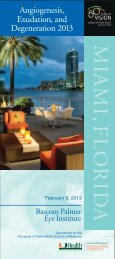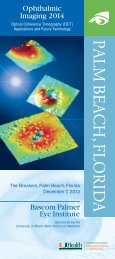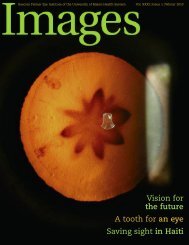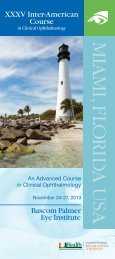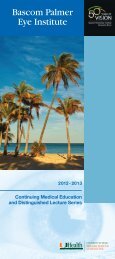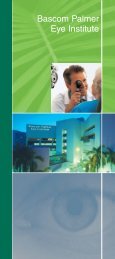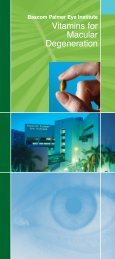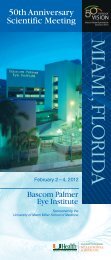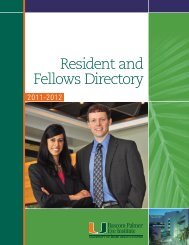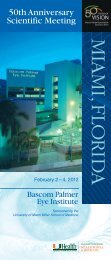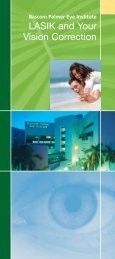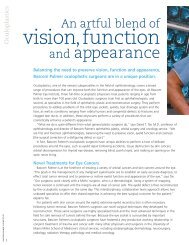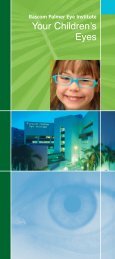Images Magazine Spring 2013 - Bascom Palmer Eye Institute
Images Magazine Spring 2013 - Bascom Palmer Eye Institute
Images Magazine Spring 2013 - Bascom Palmer Eye Institute
- No tags were found...
Create successful ePaper yourself
Turn your PDF publications into a flip-book with our unique Google optimized e-Paper software.
In 1988, Paul F. Palmberg,M.D., Ph.D., helped writeTse had developed a different approach to deliverthe American Academy ofhigh concentrations of chemotherapy directly to theOphthalmology’s guide to tumor, shrinking it prior to surgery. “This protocol hasproduced a survival rate of more than 80 percent, aglaucoma treatment and dramatic improvement over surgery alone,” said Tse.Within a year, the patient’s adenoid cystic carcinomacoined the term “targetwas gone, and 25 years later, he is still alive.pressure” to represent theIn the early 1980s, Parel began studying thebiochemistry of the eye in hopes of finding a bettergoal in halting or slowing approach to cases of advanced diabetic retinopathy,a condition that occurs when a retinal membraneglaucoma damage.grows back after surgical removal. Partnering withParrish, Parel began developing a system to insert acontrolled-release drug that inhibits cellular growthcalled 5-fluorouracil (5-FU) into the eye. Using theOBC’s resources, Parel created tiny implants made from biodegradable synthetic polymers that releaseddrugs at a constant rate for several days, weeks or months, depending on the desired outcome. Thisdrug-delivery system also held the promise of more effective treatments for some glaucoma patients.Parrish began using 5-FU for glaucoma surgery in some patients with improved results. Healso became involved in tissue culture studies that led to a randomized clinical trial funded by theNational <strong>Eye</strong> <strong>Institute</strong> called the Fluorouracil Filtering Surgery Study. The study demonstrated thatusing 5-FU resulted in substantially higher success rates in terms of controlling intraocular pressure.“Dr. Norton gave me the time to do the research,” Parrish said. “That gave me the tremendoussatisfaction of contributing to the advancement of glaucoma surgery.”After joining the faculty in 1980, glaucoma specialist Paul F. Palmberg, M.D., Ph.D., found thatcareful scanning of photographs would allow physicians to detect early signs of retinopathy causedby diabetes more effectively than with a traditional clinical examination. He also discovered that insome patients color photographs could replace a more invasive diagnostic technique that requiredinjecting a dye into the veins. The findings convinced the National <strong>Institute</strong>s of Health to launch the1994<strong>Bascom</strong> <strong>Palmer</strong>named #1 in USAFor the first time, <strong>Bascom</strong><strong>Palmer</strong> is named Bestin Ophthalmology byU.S.News & World Report,a recognition that would berepeated in 1994, 1998, 2004,2005, 2006, 2007, 2008, 2009,2010, 2011 and 2012.1994Richard K. Parrish II, M.D.,becomes <strong>Bascom</strong> <strong>Palmer</strong>’sthird chairman when Clarksonbecomes dean of the Universityof Miami School of Medicine.Parrish edits the <strong>Bascom</strong><strong>Palmer</strong> <strong>Eye</strong> <strong>Institute</strong> Atlasof Ophthalmology, hailedas “an outstandingcontribution toclinical eye care.”14



